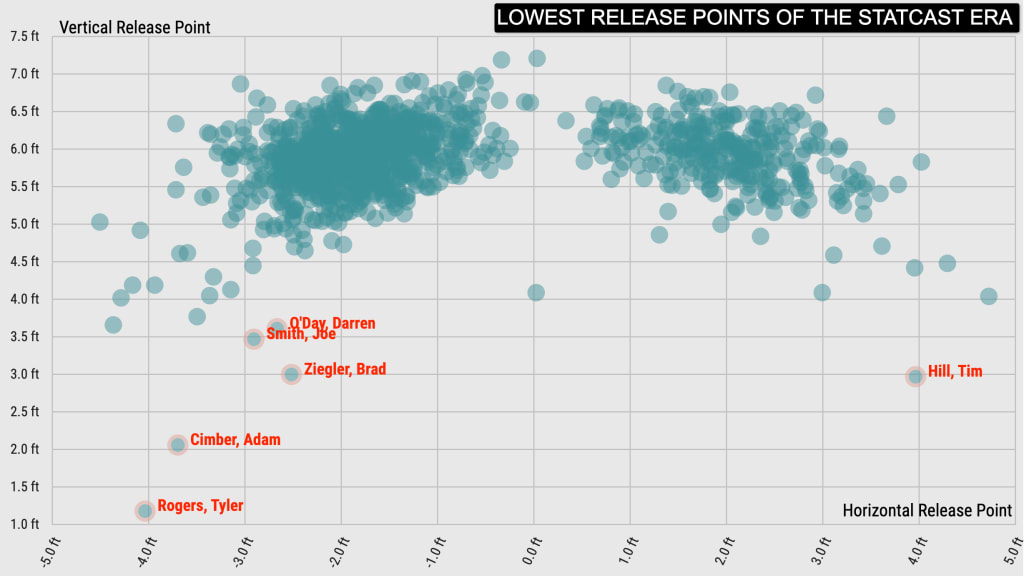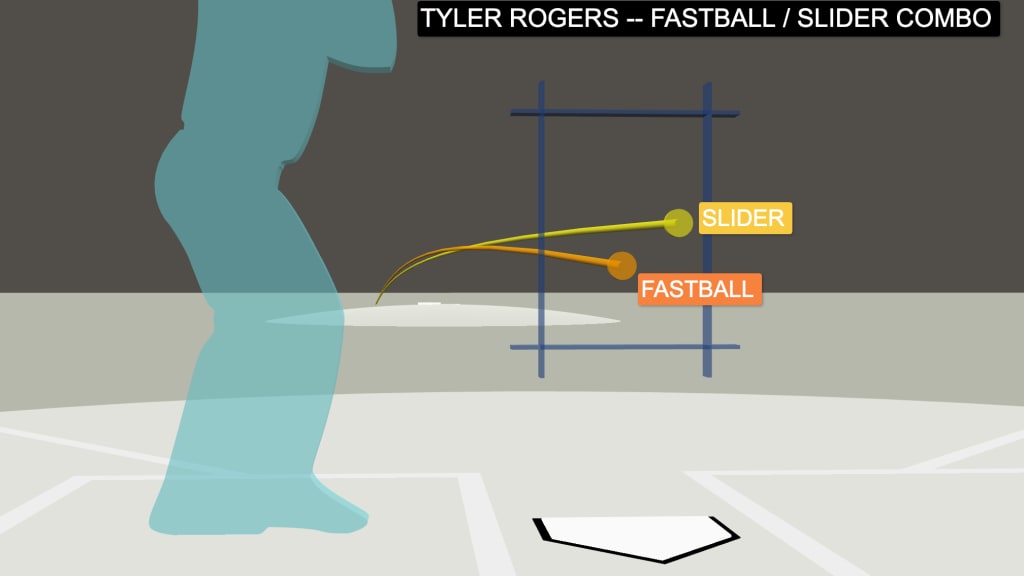Tyler Rogers, the one true submariner of the Statcast era, breaks everything we know about how pitch movement is supposed to work.
When you release the ball a foot off the ground, weird things happen. Rogers is like no other pitcher in Major League Baseball today. He's like no other pitcher Statcast has ever tracked.
Lowest avg. vertical release point, Statcast era
Min. 1,000 pitches thrown in MLB since 2015
- Tyler Rogers: 1.17 feet
- Adam Cimber: 2.05 feet
- Tim Hill: 2.96 feet
- Brad Ziegler: 2.99 feet
- Joe Smith: 3.46 feet
- Darren O'Day: 3.60 feet

Here's one lens to view the uniqueness of the Giants reliever. Rogers, who posted a 2.17 ERA in 41 appearances in the first half, throws the most common pitch combo in baseball: fastball-slider. But his fastball-slider combo is distinct from every other fastball-slider combo in the big leagues.
Think about how a normal fastball-slider combo works. Think about how a normal pitcher, one whose knuckles don't skim the surface of the mound, might deploy it -- fastballs up, sliders underneath them. Fastballs carrying through the zone, sliders following in the same pitch tunnel before breaking off down below.
Rogers inverts it. He throws sliders up and fastballs down. His fastball drops. His slider rises.
"Goodness," laughed Giants rookie catcher Patrick Bailey. "He's different. The fastballs go down and the breaking balls go up. It's funny -- you get the reactions of hitters, and umpires even, and it's like, I'm glad I'm catching and not hitting or umpiring."

Rogers' fastball drops nearly a foot and a half more than his slider on its way to the plate. His fastball drops 53 inches; his slider only drops 36 inches.
All pitches are pushed down by gravity. But we can also take gravity out of the equation and look at a pitcher's "induced vertical break" -- essentially, the movement he generates himself.
From the way he releases his pitches, Rogers induces 16 inches of "lift" on his slider -- and 12 inches of drop on his fastball.
Rogers' vertical movement in 2023
- Fastball: 53 inches total drop / -12 inches IVB (sink)
- Slider: 36 inches total drop / +16 inches IVB (lift)
"Bonkers," said Giants pitching coach Andrew Bailey. "It breaks the break chart."
So Rogers elevates the slider. He keeps his fastball down. His slider arrives six inches higher in the strike zone, on average, than his fastball does.
That is, of course, the opposite of a typical big league pitcher. In 2023, the average MLB fastball arrives in the strike zone over nine inches higher than the average MLB slider.
"You just take the plot and just … turn it," Rogers said, gesturing as if he was flipping the strike zone upside down. "Kind of like how my head does when I pitch. That's pretty much it."
The slider is the magic pitch. Anyone can throw a sinking fastball. But who throws a rising slider? Who wants to throw their sliders at the top of the zone?
"I've never seen a slider like it. It's a unicorn slider," Andrew Bailey said. "The style is super unique. Obviously there've been some submarine pitchers historically -- no one in the Statcast era that we can emulate movement or use as a comparison. I know he's had some conversations with other submariners, but in terms of pitch data and movement, it's super unicorn-y.
"We call it a UFO slider. That's what it is."
Bailey is the one who unlocked Rogers' slider's full potential.
Rogers had only pitched 17 Major League games, as a 28-year-old rookie, when Bailey arrived as the Giants' new pitching coach in 2020 and saw the UFO slider in person for the first time.
It was Bailey's idea to let Rogers unleash his slider at the top of the zone, and defy all the traditional baseball wisdom for breaking pitches in the process. Before they started working together, Rogers believed he needed to throw his slider at the bottom of the zone, to force it to break down, to try to induce ground balls.
But his slider didn't want to move that way. His slider wanted to rise. Bailey and the San Francisco coaching staff encouraged Rogers to take advantage of the pitch's natural movement and flip the way he was attacking the zone with his slider vs. his fastball.
"Before I met Bails, it was like fighting the slider to get it to go down," Rogers said. "I was always fighting against it. And then when they were just like, 'Hey, let it go' -- now there's no fighting it. It's just kind of freeing. Where I can honestly just rip it."
Bailey saw how Rogers' slider generated lift, not drop, and how it profiled akin to a four-seamer with carry. By now, three-plus years into their relationship, Rogers is all-in on the elevated, UFO slider.
"There's no real aim point anymore," Rogers said. "Kind of like if you're on a tee box and you want to hit a little baby draw, and there's nothing to aim at, there's just sky -- you just feel it. That's really the only way I can explain it. I just feel it and trust that it's gonna catch and go."
Sliders with the most "lift" in 2023
Lift = Positive induced vertical break
- Tyler Rogers: +16.4 inches
- Adam Cimber: +12.8 inches
- Erik Swanson: +9.9 inches
- Blake Snell: +8.2 inches
- Ronel Blanco: +8.2 inches
"When you see the vert on the slider, and try to forecast where those things are gonna play best -- knowing that elevated four-seamers work really well -- we knew that Tyler kind of had a backwards mix," Bailey said. "Seeing that and doing some deep dives on his location plots, we knew the slider would play up there, and then our first couple of years were dedicated to trying to get reps up there."
The rising effect is compounded by the fact that Rogers' sliders end up over a foot and a half higher than they start out. This season, he's releasing them just 1.10 feet off the ground, and they're reaching the plate 2.72 feet off the ground.
Highest avg. slider location in 2023
- Tyler Rogers: 2.72 feet
- Erik Swanson: 2.59 feet
- Adam Cimber: 2.54 feet
- Ryan Feltner: 2.53 feet
- Mike Baumann: 2.49 feet
Highest % of sliders elevated in 2023
Elevated = Thrown to upper third of zone or higher
- Tyler Rogers: 48.0%
- Erik Swanson: 44.3%
- Zack Wheeler: 43.2%
- Adam Cimber: 41.7%
- Ryan Feltner: 41.5%
"I bought in because, to get the slider to go down originally, I had to almost come up a little bit on my release point," Rogers said. "So it wasn't like an instant success, or a specific swing and miss, that showed me it was working -- it was just, like, 'I don't have to fight this anymore. I can just throw it.' That was probably the biggest thing."
He paused.
"I guess it's not really a ground-ball pitch anymore."
When Rogers was in the Minors -- where he spent over six years before his first big league callup -- coaches would see his submarine delivery and sinker-slider pitch mix and try to push him into a righty ground-ball specialist role. That's what made Rogers fight himself in his delivery. But once he got to the Majors, and especially since Bailey became the Giants' pitching coach, there was no more boxing him in.
"Beforehand, it was all about trying to get everything to move down to induce the ground balls -- but that was a long time ago," Rogers said.
It's not that Rogers is now a strikeout artist all of a sudden. His biggest strength is still inducing weak contact. He consistently holds hitters to among the lowest exit velocities, hard-hit rates, barrel rates, and expected stats in the league.
Rogers' 2023 quality of contact allowed
- Avg. exit velocity: 84.5 mph (98th percentile of MLB)
- Hard-hit rate: 29.4% (93rd percentile of MLB)
- Barrel rate: 1.5% (99th percentile of MLB)
- Expected SLG: .256 (99th percentile of MLB)
- Expected ERA: 2.00 (99th percentile of MLB)
But the difference is his approach to getting outs. It's no longer about keeping the fastball and slider down in a counterproductive effort to get grounders. It's about letting his pitches play naturally and focusing on attacking the zone, period.
"For me, it's 'strikes at all costs' with him," Bailey said. "There's some release point metrics we follow with him. But being over the white is priority."
If Rogers stays over the white of the plate, the Giants believe in the one-of-a-kind nature of the submariner's stuff to take care of the rest.
Rogers' new catcher is getting a front-row seat to what that stuff looks like for the first time. In San Francisco, Patrick Bailey is catching someone unlike anyone he's ever caught.
In Bailey's MLB debut on May 19, Rogers came in to close out the game against the Marlins. It was just the second big league inning Bailey had ever caught.
"When I first got up here, Tyler was probably the most -- I don't know if 'nervous' is the right word, but I felt like I had to be super locked in to catch him," Bailey said. "Just because the stuff moves differently, and it always moves differently at different points."
The final pitch Rogers threw that day, the final one that Bailey had to catch, was the UFO slider. It struck out Garrett Hampson to seal the Giants' win.
That Rogers slider started 1.11 feet off the ground when he released it. It was 3.42 feet high by the time it reached Hampson. It had over 17 inches of induced rise.
"It's like a rising Frisbee," Bailey said. "The ones that clip the bottom of the zone look like they scrape the dirt, and then the ones that end up elevated look like they're right down the middle. And then they just keep going."
